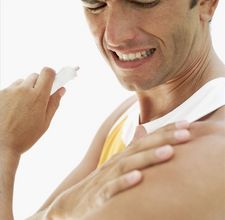Last week I started counting down the top 10 myths about fitness and nutrition. Click here to read myth #10: being skinny means you are healthy.
Today I’m clearing up some confusion surrounding soreness. The largest myth related to the topic is that lactic acid causes soreness. It does not. Lactic Acid or lactate is produced during the metabolic process that gives us the energy to do physical work. People once theorized that it causes soreness and fatigue because its production increases steadily as one becomes closer to failure, and getting to this point often results in soreness. However, we now know that lactate is beneficial for us- it is picked up by the b rain, heart and skeletal muscle and used as another source of energy.
rain, heart and skeletal muscle and used as another source of energy.
Another misunderstanding is the belief that soreness can be used to gauge how hard you worked out. Not necessarily. Soreness is mainly a measure of how novel an exercise was for your body. If your body is not use to an exercise, it will elicit a great response to that stimulus, and that is the soreness you feel. Of course, if you do an exercise that your body is familiar with, but is of a higher intensity than you’ve done before, then you’ll feel sore. But the greatest source of soreness is from novel stimulation, so you can’t draw a direct correlation simply between exercise intensity and soreness.
This has two practical implications:
1) it means that you should not be discouraged by the extreme soreness that you experience when starting a new exercise program. Once your body adapts to that form of exercise, much of that soreness will subside.
2) You do not need to feel as if your workout was subpar if it doesn’t result in a great deal of soreness. If you’re doing a workout that your body is familiar with, then soreness will likely only be felt if you reach a very difficult point for you, and even that will not be as great as the soreness brought on by novel exercise.
In the comments below, tell me: does this surprise you? Also, are there any fitness/nutrition myths out there that you have questions about or that get on your nerves? Let me know!
If you’re not on my list to get more health tips like these, enter your name and email below.





Does this surprise me? No… it is confirmation and clarification from a professional of what I thought to be true, though the lactic acid information is new to me. (And now you have confirmation that someone read your comments!)
Thanks Tom!
Karlie
With regard common misconceptions and exercise, for years we were reminded how important it was to warm up before exercise. I used to spend some time going through a regime of stretching befofe execise then read an article that suggested it isnt that important. I now do little warm up, with no negative effect on performance. I do still take time to stretch after exercise. Your thoughts? Steve
Hey Steve – yes, this is an area where there’s been some changes in recommendations over the years. Most exercise physiologists now believe that a warm-up (light movements that move the joints through a large range of motion) is very beneficial to make the muscles more pliable, preparing them for the upcoming exercise. Sometimes this is called “dynamic stretching.” While static stretching is really important in order to maintain flexibility, it should really be done when the muscles are the warmest – after the workout. I actually wrote a bit about this earlier this year. Here are those articles:
http://new.fitfordutyconsulting.com/2015/02/the-most-common-misconceptions-about-firefighters-and-stretching/
http://new.fitfordutyconsulting.com/2013/06/the-one-stretch-that-firefighters-should-avoid/
http://new.fitfordutyconsulting.com/2013/06/a-warm-up-fit-for-firefighters/
You still never stated exactly what the soreness is inside the muscle. Is it slight muscle tearing, is it actin and myosin paddle friction wearing, or something else? People want to know.
The general consensus is that there are microscopic tears produced in the muscle which is what causes the sensation of soreness. This is part of the adaptation process that increases the size and strength of muscles.